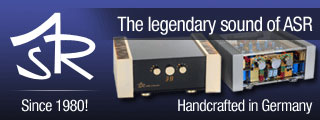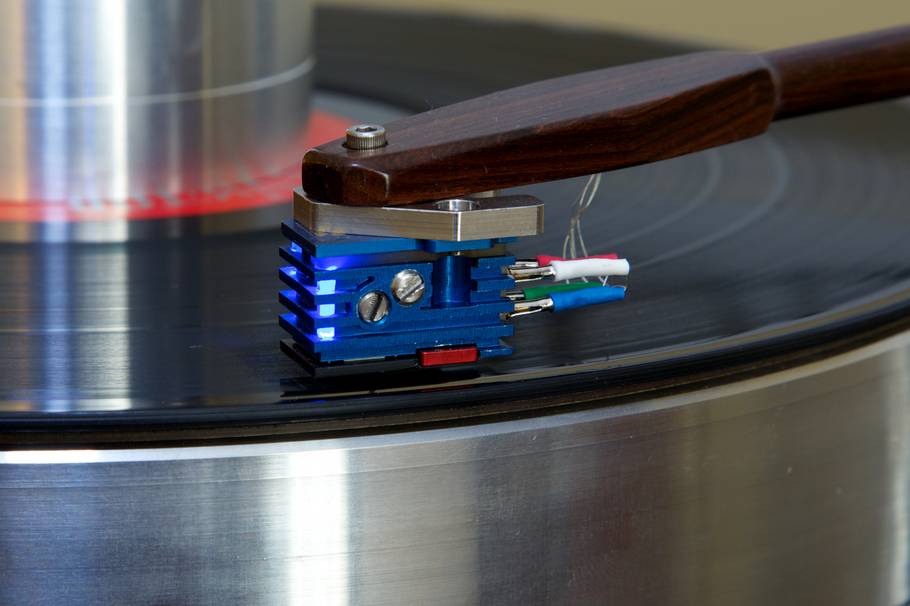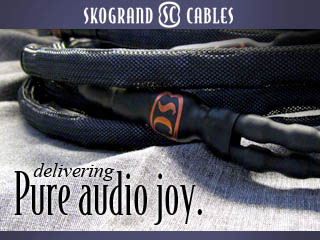Tracking
The only tonearm I used the SG-220 cartridge in was my AMG V12 twelve-inch tonearm. The 12 gram mass and the ingenious bearing of this arm seemed to be perfect for the SG cartridge, as it out tracked anything I have used. It is the best tracking cartridge I have ever used, surpassing the superb tracking ZYX 4D G SB2 cartridge . Most modern cartridges track well, but the SG-220 was at the very the top of the pack. In fact, it tracks so well at such a broad spectrum of tracking forces that it allows you to have such a range of setup.
Initial Reaction
As my regular readers know, I spent many years listening to Quad 57 electrostatic speakers. I will never forget the first time I heard them. It was at Baylor University and the album was Cat Steven’s Teaser and the Firecat. The reason I remember it now 39 years later is because the sound such a revelation. I was blown away by the transparency of the midrange and the speed of the bass; of course, I didn’t know those terms at the time.
I’m not the first to say it, but that is exactly the same feeling I had when I installed the SG-220 cartridge and preamp in my system. My first impression after a few hours of break-in was that a properly set up Soundsmith strain-gauge cartridge reproduces the cleanest, clearest, most transparent midrange and top end I had heard. It also had the fastest, most dynamic bass I have heard. It also let me hear more air around and within instruments and more of the hall than I had heard by a large margin. Lastly, it produces by far the most three-dimensional soundstage I have encountered. Let me stop right here and say that most products that wow me like this at first, often in the end do not end up being as musically and emotionally involving as I want a product I own to be. So having said that, let’s see what a few weeks of listening did for the way I feel about this cartridge.
The first session I had with this cartridge with only about 6 hours on it my listening room had records everywhere. My oldest son dropped by unannounced and we started pulling out LP after LP. We were so impressed by its immediacy and straight forward sound. One of my first thoughts was of the ‘positive scanning’ Decca pick-ups I used to love so much. I called Warren Gregoire of WGA and told him I had found a London Decca that could track. Its speed and agility is spell binding and the way the Soundsmith delivers bass information is very reminiscent of the Decca cartridges that don’t have a cantilever. While it has the slam and speed of the Decca’s bass, it lacks the Decca’s tracking difficulties. A few weeks later Warren came to hear it and we both agreed it not only tracked better than the London Reference cartridge, but bettered it in every way.
After a few days, I thought again the cartridge was sounding too lean and I wondered if maybe it just wasn’t the perfect match for my system. So I put back in the Miyabi Standard and thought it had a warmer tonal balance, but after a few days I missed the strain gauge’s incredible clarity, immediacy and solid three-dimensionality. So, I took it back out of dismissal and begin to set it up again. That’s when I noticed I wasn’t paying close enough attention to how far back the stylus sits in the cartridge body. A little time resetting everything while paying attention to this and I put it back on to play. Wow! What a difference this made. The lean sound was gone and the bass was even better. The top end sounded just as extended, and even more beautifully.
So what does it sound like?
Maybe I should start by saying it doesn’t sound like anything I have heard before. It doesn’t exactly sound like what I have come to expect vinyl to sound, nor does it sound anything like digital. There is a naturalness, ease, and total lack of coloration that I wasn’t prepared for; you probably won’t be either the first time you hear it.
Like the AMG V12 turntable and the High Fidelity Cables, it’s equally important what you don’t hear with this cartridge. The SG-220 is the quietest preamp/phono cartridge I have heard by a big margin. There is no hum, no electrical noises, and an incredible quietness to the background of music. This quietness doesn’t miss things like tape hiss at all; in fact, this quietness let’s you hear everything. I have never heard anything like the beautiful way this cartridge plays soft passage on LPs. If you’re looking for a forgiving, warm, more beautiful-than-reality cartridge, this isn’t for you. If you’re looking to hear what’s hidden in those grooves, and hear it in a way that is remarkably alive sounding, then read on.
If you like to listen to music at low levels, this is the LP playing system for you. If you really like to crank it up, this still is the cartridge for you. I have heard very few speakers or sources that I could say sounded just as good at really low volumes or really high ones before. The combination of the Soundsmith SG-220 and my Teresonic Ingenium XR Silvers do exactly that, though. Like with my old Quad 57, the volume control seems to move you closer or farther from the music as much as it makes it louder or softer. Unlike the Quads, this system can be played at lifelike volumes or even louder.
One last general comment about the sound. With this cartridge in my system I hear so much more of the hall, club, or recording studio than with other systems. Live albums like Peter, Paul, and Mary In Concert or The Weavers Live at Carnegie Hall were almost disturbing at how you could hear individual voices singing in the audience, and the clapping was so alive. It is so much more like hearing the recording in person among the audience than listening to a live recording. This is equally true of studio recordings; it is so obvious when microphones are turned up or down. Sometimes it is even possible to hear a mic become live that had been off. Sadly, it is also easy to hear when certain microphones on certain instruments are hotter than others. Still, I warn you when you get used to hearing this kind of space, hall sound, and real air it’s very hard to go back to even the best moving coils.
Bass
I have to admit I was shocked by the precision with which the SG-220 played bass in my system. The bass is one of its strongest points. Whether it was drums, acoustical or electric bass, the impact and speed were spot on. There is a fundamental rightness that seems to complete the transformation my system has gone through with the addition of the AMG V12 turntable and the High Fidelity Cables. The amazing thing was that once I got the geometry right, it let me hear the air and warmth without even the slightest hint of boom, looseness, or hangover in the bass or mid-bass. I was really surprised that a system with this kind of speed, detail, and quietness could have such beautiful harmonic structure; I found it quite beguiling.
The characteristic sound of the bass was carried all the way up into the upper mid-bass. The cartridge provides fast attacks followed by beautiful full decay that lets me hear different layers of the timber of the instruments. One of the most amazing things is to listen to a standup bass and hear the fingering, the air around the fingering, the air within the standup bass, and the space it was played in. I have never heard all of this all at once before. My system with the SG-220 has the most lifelike bass I have experienced. I know my speakers only go into the low 30s, but the bass I have is just so lifelike. The most amazing thing is that it produces this bass effortlessly and sound so fundamentally right.
Rereading this section, I see I haven’t talked enough about drums. No system I have heard plays drums as realistically as mine does with the SG-220 as the source. The way you can hear the skin, the decay, the different sound different sticks sound, and most of all the impact of the sound and the air of a bass drum. It simply sounds more like drums.
- ← Previous page
- (Page 2 of 4)
- Next page →





I’ve been fortunate enough to have owned a Strain Gauge cartridge for nearly 2 years now. Whilst your review may appear as an uncritical gushingly positive review, it is in concordance with my own experience. All I would add to your review is to emphasise how well the SG presents musical timbre, it isn’t just drums that sound like real drums, all instruments are presented with a natural life-like timbre.
The other interesting observations with this cartridge are:
That some LPs that sounded terrible with my previous cartridge (ZYX Airy 3) now sound great, but also vice versa.
Part of what is different is the incredibly low noise floor, I never realised how noisy MC cartridges were until I didn’t have one.
Mono albums sound great with this cartridge, nobody else had mentioned this before – I thought that it was just me!
It was interesting that you mentioned the Decca London, I had an original Garrott Brothers modified Decca and this has been the cartridge that I’ve enjoyed the most until I bought the Strain Gauge.
Thanks Prof for reading the review and it’s great to hear that you have had the cartridge for two years and still loving it. To me that says it all. It’s not uncommon for people to love a new purchase and with time to feel it wasn’t as good as they thought.
Thank you so much for your comments and I agree with your comments about the timbre of instruments. Now that I’m just listening to music and not reviewing it I am enjoying it even more.
Dear Mr. Roberts,
I completely agree with you about the Strain Gauge principle. Almost fifty years ago, as a student, I got the opportunity to help to build the Euphonics Miniconic System. The Design was straightforward. We had two problems; first because of the construction, one of the two channels needed an
inverter-stage (At that time we had only some Ge-transistors and no differential-amplifiers!). The second problem was the choice of the best
material for the suspension.
Fortunately, at NASA in Houston, they stock an enormous choice of different rubbers. We decide to use a natural butyl-rubber… They were endless discussions about the influence of the rubber in the resulting aesthetic of the sound!
Now, I am still using the Euphonics, together with the SG RAM preamp that Peter Ledermann designed for the Matsushita SG at RAM Audio. About wearing? From my own experience, no problem after 45 years of use. I had some trouble at the beginning, not because of the SG, they were already very reliable (NASA used them to test the deformations on the Polaris-rockets) but the contacting between the small epoxy SG-holder and the outside world was very poor. On my system, I took out the contacts, just soldering four tiny wires direct on the epoxy.
About my sound experience; I had plenty of carts (MM-Shure, MC-Dynavector, etc) I still prefer the sound of the SG. It gives me fantastic dry bass and crystal clear high frequencies. I connect Mr. Ledermann’s RAM preamp direct to the power amplifier. Especially if you use Direct Disc Records (Sheffield Labs, Three Blind Mice) you get a near reality sound experience!
Now, as a retired engineer, I hope that I will raise enough money to afford the SG-220.
I hope I was not disturbing you too much with my stories. Thank you very much for your engagement for the survival (or revival) of the
SG-principle. A system responding to the displacement (amplitude) will be, for me, always better than one using the derivative of the signal (velocity)!
I send you my best regards
Dr. Yves Lehareinger
P.S. Almost 50 years ago, I got the same feeling as you, discovering Peter Walker’s wonderful ELS 57!
Many years ago I, for a short while owned a Win SG. As I have heard here, I’m recalling a not so subtle difference in the reality presented with the strain guage. It’s startling.
On the opening of one of my favorite albums, Better Days by Paul Butterfield, there is a short dialogue. “OK Nick” I believe one of the band members says. My dog Lea jumped up, although she had heard the album many times. Closest to reality of any medium of reproduction I’ve ever heard. One day sir, one day I’ll have one.
Peter’s miraculous Strain Gauge has been my reference cartridge since 2011 and is used each week by to dub vinyl sources for my web show “The Vinyl Experience.” I concur with all of the observations of this comprehensive review. It sounds neither analog or digital, but rather like a unique window into original sources. I too have wrangled the joys and sorrows of the quirky London Decca line of cartridges and find the SG to absolutely be a ‘Decca that actually tracks,’ a unicorn in the Hi Fi woods if there ever was one. Most significantly, our glowing little blue creature is it’s own animal, and a brilliant reflection of it’s creator and his own clear values. The cautionary words about geometry and set-up are well advised–I’ve lived with mine for nearly a college-career of years and I’m still tweaking. This is a cartridge that rewards a well-balanced system of components that get out of the way, and that includes simplifying all aspects of set-up. If your tonearm eschews goofy little things like height or azimuth adjustment or wiggle room in those headshell slots, you’re sunk. A Soundsmith Strain Gauge demands it, and delivers rewards in proportion to the effort expended. It’s a tweaker’s cartridge, and proudly so. The great thing about vinyl: if you just want to “never mind the bollocks’ and simply play records, you can spend hundreds-not thousands-and get bang for buck with wonderful new things like (for instance) Rega’s P1. But if tweaking is the whole idea, and peeling the layers of the audio onion your great pleasure, every penny spent on the SG will come back to you in glorious dollops of obsession.